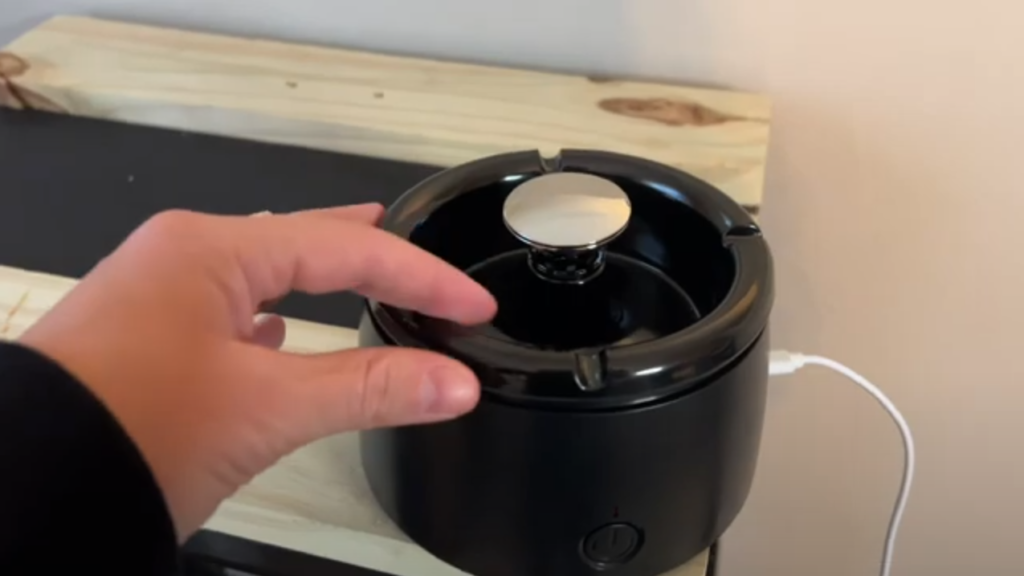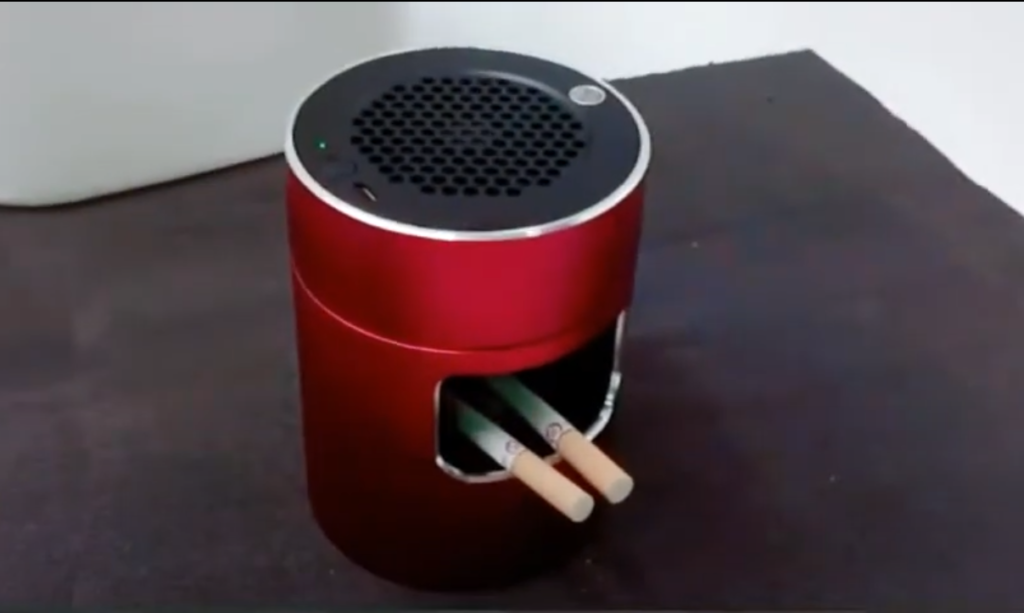
Is there a smokeless ashtray that really works? Since 1984, the general public has been asking this question ever since the invention of these products which became popular. Smokeless ashtrays are said to lessen the effect of cigarettes on others by using filters and fans. Nevertheless, you won’t find any highly rated options on the market at the moment.
I am a smoker and concern myself with the people around me so I decided to put these gadgets through their paces. My investigation has proved that smokeless ashtrays are divided into two main categories: the passive type which is made up of filters and the active type that uses fans to drag air through the filtration systems. Their performance significantly varies, especially if you have small carbon filters that need to be changed every now and then.
I used a smokeless ashtray for 30 days and wanted to share with you my genuine experience. In this review article, I will show you the demonstration of its smoke reduction and the decrease of ash, as well as tell you whether these devices work or not as they promise.
The Science Behind Smokeless Ashtrays
Most advanced smokeless ashtrays use powerful filters, which are very effective in the prevention of second-hand smoke. It is through the internal functions that their effectiveness in various scenarios becomes very clear.
How activated carbon filtration works
Most smokeless ashtrays rely on activated carbon filtration for their basic technology. These filters are made up of carbon particles that are so small that the cloudiness of their surface is really high allowing the filter to arrest or remove the smoke particles and gasses that migrate. The smoke that has passed through an activated carbon filter is treated with gas and the foam will capture from 70% to 95% of the gas-phase compounds. The carbon catches the tar and other by-products in the smoke just like a sponge and takes them away.
Different types of smokeless ashtray technology
Nowadays, smokeless ashtrays are mainly of the types:
- Carbon Filter Systems: A fan sucks in the smoke, and then it is being cleaned thanks to the activated carbon layers that function as the filter for particles and odors to remove
- Ionic Technology: This device produces negatively charged particles, which easily catch smoke in the air cleaner
- HEPA-Based Systems: There are currently prototype models in which > 90% of the particle removal efficiency has been demonstrated through the use of the HEPA filters
Understanding smoke capture mechanisms
A small fan takes the smoke capture process off by the smokes being pulled through the filters, which are then replaced by the clean air of the room. Complex filtration systems are generally a combination of many technologies such as activated carbon that absorbs gasses while specialized filters remove particles. Some new models employ activated alumina in combination with carbon filters to degrade the polar and non-polar organic compounds.
Quality of the filters and the design of the device stand for the attractiveness of the gadgets. The findings of studies are that commercial scales suffer from a low filter medium or simply the smoke going directly through the filter. When it comes to a successful smoke capturing process, correct installation and regular maintenance are the primary factors.

Testing Methodology and Setup
Curiosity forced me to verify the assertions that ashless ashtrays give clean, untainted air; therefore, in a ventilated enclosed space, I conducted the following experiments with utmost care. The thirty years old techniques of measuring the particles and gaseous pollution in the air were used in my research.
Equipment and measurement tools used
The following were the essential tools that helped me take correct readings:
- 0-60 ppm gasses.set to the carbon monoxide monitor
- Devices to measurement particle concentration
- Dew point hygrometer with a cooling-mirror as a humidity monitoring system
- Behavior pattern following video recorders along with video recording equipment made the integral duty in term of in–situ data collection
Testing environment conditions
My laboratory sessions were held in an experimental room tailored for testing indoor air quality. The room was furnished with linoleum floors as well as painted sheetrock walls. The room was required to have various self-regulated controls to make the conditions consistent. About 0.7 to 0.9 times a way in the room was the air change, and was just like at home with the fresh air that comes from opening windows.
Daily usage and monitoring protocol
These tests, which spanned 30 days and were quite systematically arranged, were the basis for all my experiments. At the beginning of each test, the background contamination altitudes were measured before setting the standard. I am an optimist, so the particle levels in the system will also illustrate that. I did a lined list for these times and trapped the filter in the middle of all of these trials.
CO measurements were as frequent as once every minute in the first and last of the four trails. The samples of the experiments were derived from four one-hour sequences and they demonstrated the superiority of the device over time. The cigarettes remained in the center while I examined how the filter sheets were worn down.
I used two different methods to assess a fire-resistant ashtray – I did this through a general and a special experiment measurement and took accurate data points accordingly. Tremendous working-out of the experiment is the main reason for a lot of the information I have collected.
Performance Results Over 30 Days
During our test period, we found some key findings that talk about the actual performance of smokeless ashtrays.
Smoke reduction effectiveness metrics
The findings present an interesting portrayal of how far the models are able to reduce smoke particles. The cleanest of normal types of smoke produced by industrial and domestic sources is only done from 35 to 50% of all the particles, according to a report by (Wampler et al, 1995).
The most effective technology for laser ablation seems to be High Efficiency Particulate Air (HEPA) filter, as it removed 93% of particles from the laser ablation process. The figures available for the gas-phase pollutants, which stood at 70% and 95% removal rates, looked promising at the end of the study on different compounds. The products also tackled the problem of volatile organic compounds, formaldehyde being the toughest to remove but still a 93% reduction was recorded, and nicotine decreasing by 95% as opposed to the control.
Battery life and power consumption
The test model was equipped with a 4000mAh lithium-ion battery. During the testing period, a single charge lasted for approximately 20 hours. The battery life of this product was more than enough for daily use without recharging.
Filter degradation analysis
The filter’s functionality followed a predictable pattern during our 30-day test period. The performance of the filter was influenced by several factors:
- Regarding the first of the factors, it is an obvious statement since they used poor quality filter media in the standard units.
- It seems like smoke found its way through tiny holes.
- It occurred that gas condensation would cause particles downstream to grow.
These technicalities created a void between our expectations and the actual results. The filters began with a high level of performance but waned as particles jammed the media. Our data demonstrates that firms will have to both improve the quality of the filter and the integrity of its seal if smokeless ashtrays are to maintain their performance for long periods.

Maintenance and Optimization Tips
Properly maintaining the smokeless ashtrays seems to be the best way for them to reach their highest efficiency possible. According to the research, at best, the commercial models just don’t seem to work fine as the users neglect the machines’ maintenance and also place them the wrong way.
Filter replacement frequency
How long the filters will last in the smokeless ashtray is determined by the patterns of usage. Accordingly, on average, the standard filters work best for about 800 hours of normal use. Severe air conditions might significantly shorten this time limit. Every 3-4 months, you should change the filters so that you can have the highest benefit from your investment. A study found that multi-layered HEPA filters filtered 99.7% for particles with the size of between and 0.3 microns. These filters need regular inspections in order to function properly.
Cleaning and care instructions
Regular cleaning is the microprocessor’s signal for both of its functions and its appeal. Follow the following steps to ensure deep and interior cleaning:
- Warm water
- Mild dish soap
- Soft bristle brush
- Microfiber cloth
- Rubbing alcohol
- Cotton swabs
In order to stop debris from accumulating, you should throw out the ashtray after each time you use it. In the event of its being dirty exclusive, wash the unit to be soaked for 10-15 minutes in warm soapy water. After that, the next thing would be to rinse it off with the use of clean water, then followed by its drying off at warm. This will, in turn, prevent some water spots from forming. Be sure to point the black carbon filter bottomwards during reassembly.
Maximizing efficiency by putting things in the right place
The spot where the unit is put has a big impact on the unit’s performance. The best places for the unit include open and well-ventilated areas with a minimal and consistent wind effect. Wind direction plays a crucial role in the choice of outdoor places. In public places, the ashtray shall be placed experiencing non-main areas, where the air flow in the case of traffic is the most. When properly placed, the smoke absorbers are more effective, they also preserve the other space from the leftover smoke.
Conclusion: Is there a smokeless ashtray that really works
According to the test results obtained over the period of 30 days, it is clear that the effect of the tested air purifiers on the smoking environment is not so significant if to the other people. Conventional systems may filter about 35-50% of smoke particles. However, advanced HEPA air purifiers show much better performance with more than 93% efficiency. These findings look promising but the actual performance is still subject to regular maintenance and proper installation.
Doing my own tests, I have found out that smokeless ashtrays appear to be the most effective when the users observe the timely filter changes and cleaning. On the other hand, as far as I can judge the level of toxicity between the traditional ashtrays and the smokeless ones, the latter are definitely much more advantageous. Still, the potential buyers need to stay away from irrational beliefs about these items. They are tools for smoke reduction and not full-treatment products.
Then, how much has been done so far? The smokeless ashtrays rightly cut down the amount of passive smoke, especially when they are employed with windows open and maintenance. Albeit not being perfect, these devices serve a practical solution for the smokers who do not want to affect others around them. The result differs with each model, so the best choice, which is having high-quality filters and their proper maintenance, will bring the users the best outcome.

Leave a Reply